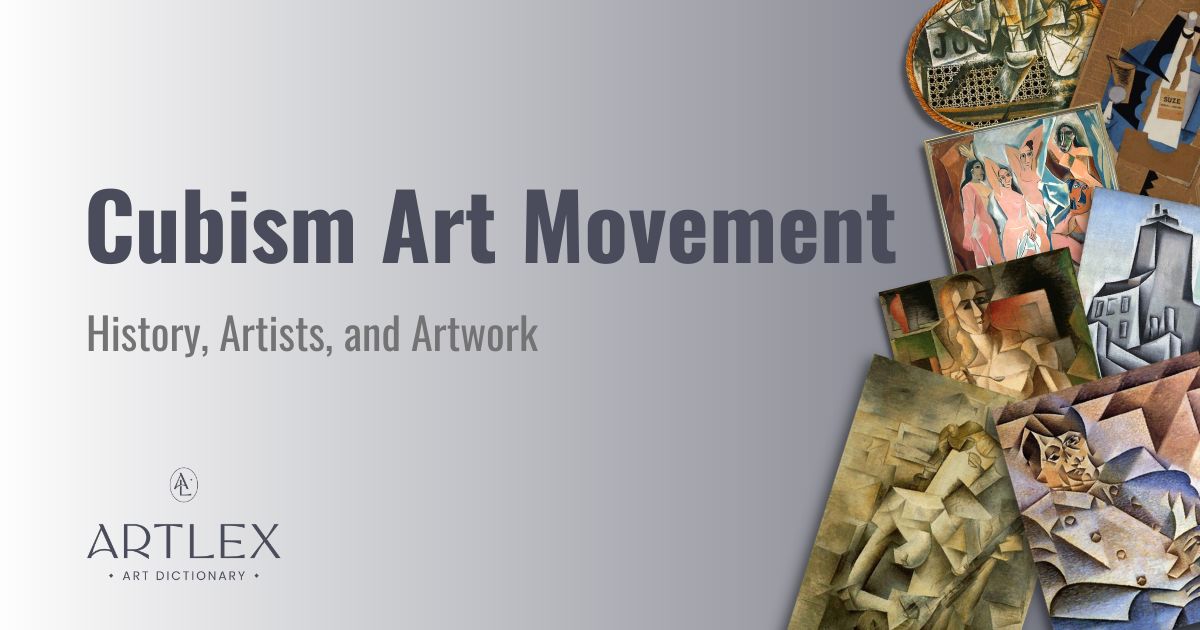
Cubism is a Western modern art movement that began around 1907 in Paris, France and started to decline in 1914 with the start of the First World War. Although the original Cubist movement changed dramatically during this time, its influence lived on in art movements like Futurism, Constructivism, Abstract Expressionism, and others.
Cubism was led by artists Pablo Picasso and Georges Braque, who experimented with form and perspective. Picasso and Braque’s many experiments achieved Cubism’s main characteristics, including a fragmented, flat, and layered composition, multiple perspectives represented in a single picture plane, and a limited color palette. Cubism refuted the notion that art should imitate nature.
Iconic Cubist artworks include: Les Demoiselles d’Avignon (Pablo Picasso, 1907), Portrait of Pablo Picasso (Juan Gris, 1912), and Still-Life with Chair Caning (Pablo Picasso, 1912).
The History of Cubism
Cubism was invented in 1907 by Pablo Picasso and Georges Braque. Picasso and Braque were influenced by the Post-Impressionist work of Paul Cézanne, African Art, and Iberian sculpture.
The pre-Cubist phase is sometimes referred to as Proto-Cubism or Cézanian Cubism. This phase refers to when Picasso and Braque developed the Cubist style between 1904 and 1907.
Picasso and Braque established the two main phases of Cubism, Analytic Cubism and Synthetic Cubism, which reached their peak between 1907-1912 and 1912-1914, respectively.
The original Cubist movement began to shift around 1914 with the start of the First World War. The war displaced many artists working in Europe at the time, causing them to flee or go into hiding. Some male artists of military age also had to serve their country, which required them to pause their artistic practices. Many paintings were also lost or stolen, if not already in possession of a collector, museum, or other safe location.
After the war, many Cubist artists continued to paint, which led to an evolution in the Cubist movement. Cubists began to favor a more abstract style, eventually leading to sub-genres within the Cubist movement, such as Abstract Cubism and Transparent Cubism, among others.
F0r more information, see our Cubism History article.
What were the Phases of Cubism?
The phases of Cubism are Proto-Cubism/Cézanian Cubism, Analytic Cubism, and Synthetic Cubism.
Analytic Cubism emerged in 1907 and consisted of paintings that emphasized the flat, two-dimensional surface of the picture plane. Analytic Cubism rejected the traditional techniques of modeling, foreshortening, perspective, and chiaroscuro to create depth and the illusion of three-dimensional space. Analytic Cubist paintings typically featured a limited color palette consisting of earthy tones and many shadows.
Synthetic Cubism emerged in 1912 and developed upon the flatness of Analytic Cubism by incorporating everyday objects into paintings. Bits of paper once belonging to newspapers, wallpaper, bottle labels, and other ephemera were pasted by artists onto the canvas in addition to oilcloth and oil paint. The color palette seen in Synthetic Cubism paintings remained limited but is not as monochromatic as the color schemes popular within Analytical Cubist painting.
Cézanian Cubism
French Post-Impressionist artist Paul Cézanne primarily influenced the Cubist movement, resulting in the name “Cézanian Cubism.”
Cézanne’s experiments with planes and form, his use of hard lines, geometric shapes, and simultaneous perspectives profoundly impacted Cubism’s aesthetic characteristics.
Cézanne often reduced his subjects to their primary geometric forms. For instance, a tree was a strategic combination of cylinders, and an apple was a sphere. Cézanne also experimented with the rules of perspective and painted his objects with flattened surfaces, hinting at the three-dimensionality of a subject by suggesting multiple angles and points of view at once.
Ultimately, Cézanne’s late Post-Impressionist style influenced Picasso and Braque’s pre-Cubist artwork. Proto-Cubism refers to the phase of artistic experiments conducted by Pablo Picasso and Georges Braque between 1904 and 1907 that drew on many influences, including Cézanne’s unique style. Picasso and Braque carried many Post-Impressionistic characteristics into the development of Cubism, producing artwork is flat, geometric, and angular, with an earthy color palette.
See our article to can read more about Paul Cézanne’s Influence on Cubism.
Analytic Cubism
Analytic Cubism refers to the first phase of Cubism that developed in France around 1907 and lasted until 1912. Analytical Cubism describes artists’ analytical, piece-by-piece approach to representing their subjects. Subjects were analyzed, deconstructed, and rearranged to be fully visible from one side. This aesthetic dissection of form resulted in multiple overlapping viewpoints that allowed the viewer to see the subject in its entirety on a single picture plane.
These stylistic choices resulted in Cubist artworks having a fragmented, geometric, and abstract appearance. Analytic Cubist painters also used a limited color palette, primarily dark, earthy tones.
Analytic Cubism differs from previous art movements such as Impressionism, where the composition is also fragmented to the point of abstraction. However, Impressionist artists used vivid colors that emphasized the effects of light on nature. On the other hand, Cubism overlapped multiple angles and picture planes that caused the subject matter to look highly unrealistic but still identifiable.
Examples of Analytic Cubism artwork include:
1. Houses in Paris

2. Tea Time (Woman with Teaspoon)
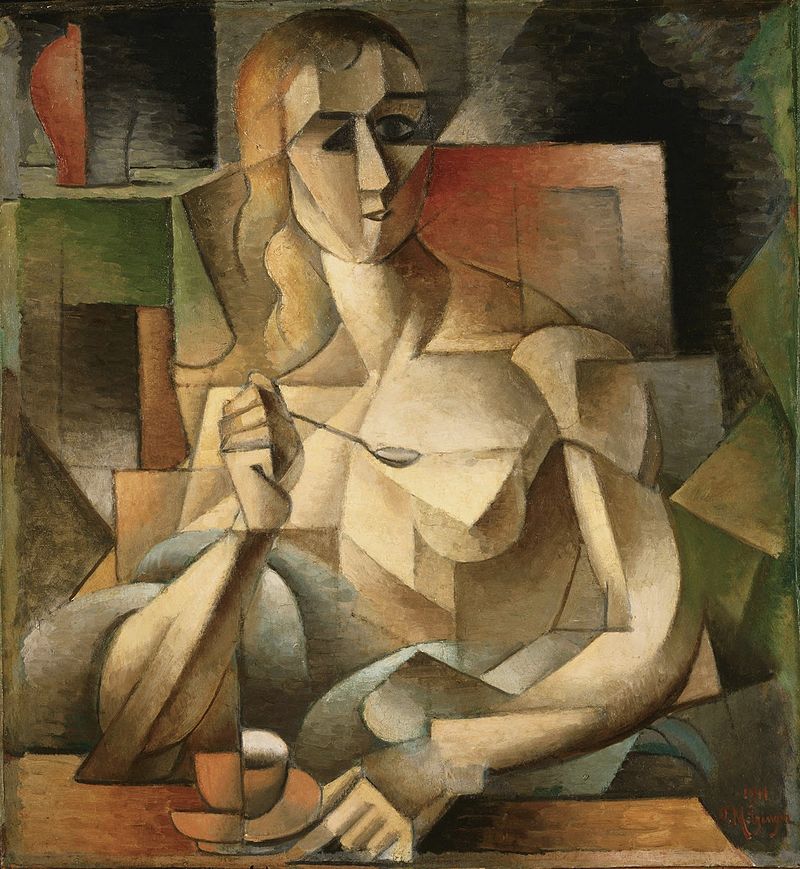
You can read more in our Analytic Cubism Guide.
Synthetic Cubism
Synthetic Cubism was an art movement that occurred in France between 1912 and 1914. Synthetic Cubism is characterized by flat depictions of everyday objects, and bolder, more symbolic compositions than its precursor, Analytic Cubism.
Much like Analytic Cubism, Synthetic Cubism was led by artists Pablo Picasso and Georges Braque. By 1912, many more artists were working alongside Picasso and Braque in the Cubist style, including Jean Metzinger (1883-1956), Albert Gleizes (1881-1953), Robert Delaunay (1885-1941), Henri Le Fauconnier (1881-1946) Fernand Léger (1881-1955).
Many art historians also acknowledge the artist Juan Gris (1887-1927) as a critical figure in the evolution of Analytical Cubism to Synthetic Cubism.
Unlike the deconstructive process of Analytical Cubism, artists working in the style of Synthetic Cubism represented their chosen subject matter, usually real objects and people, through a combination of everyday materials and oil paint.
The colors used in Synthetic Cubist art are varied and more vibrant than the limited palette of Analytic Cubism. The neutral, earthy color palette of Analytic Cubism evolved to include more bold colors and simple shapes while maintaining the overlapping viewpoints already central to Cubist works. The shift to the bold and unblended color seen in Synthetic Cubism is often considered to be a precursor to the simple yet vibrant artworks of the Pop Art movement.
Papier collé, the pasted paper technique we now know as collage, also emerged from Synthetic Cubism. The method of pasting bits of paper onto a flat surface such as a canvas was often used by Cubists to confront the viewer with actual pieces of reality. The connection to reality was especially important during this time, as it reflected a critical take on a rapidly changing society and an impending World War.
By combining traditional art materials with scraps of real-world objects, Cubists demonstrated how introducing physical elements into painting and synthesizing them into a new style could influence generations of artists to follow. The papier collé technique expanded the definition of art by introducing mixed media art making to the modern art world.
The political commentary critical to Synthetic Cubism also influenced the art movements that emerged during both World Wars and the post-war period. The faceted, multi-dimensional forms of Cubism directly influenced many 20th-century artists and Modern art movements such as Dadaism, Surrealism, Futurism, Suprematism, Constructivism and De Stijl.
Examples of Synthetic Cubism artwork include:
1. Glass and Bottle of Suze
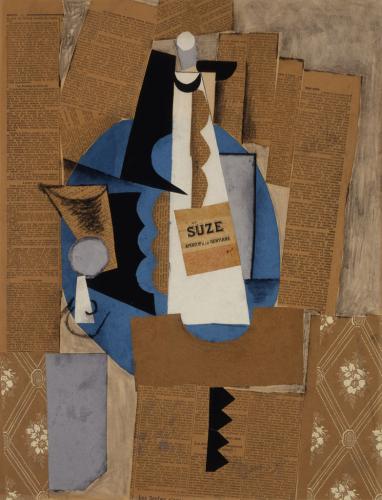
2. Still-Life with Chair Caning
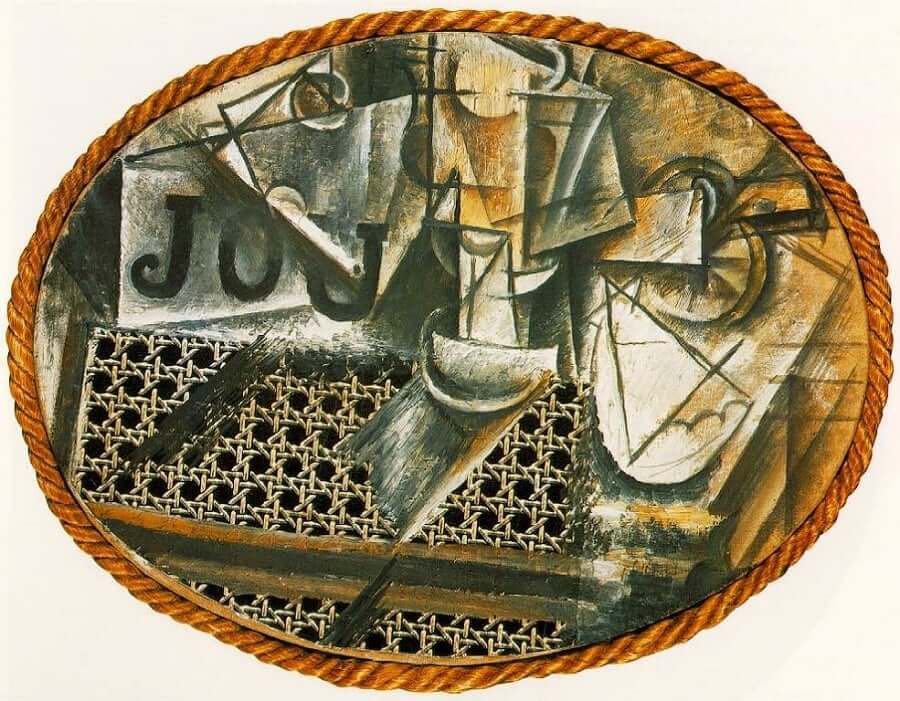
You can read more in our Synthetic Cubism Guide.
Characteristics of Cubism
The main characteristics of Cubism include multiple perspectives, geometric shapes, a monochromatic color palette, and a flattened picture plane.
Cubism’s unconventional handling of form, color, and perspective signaled a shift from the once-revered institution of European modernist painting. Cubism reimagined the treatment of form by rejecting the principles of perspective, modeling, and foreshortening. This process resulted in a geometric, heavily abstracted composition that represented the subject from all angles and with overlapping picture planes.
Cubists were masters at analyzing the appearance of their subjects and combining multiple viewpoints into a single form. Cubist artists depicted their subjects from multiple perspectives simultaneously, working to represent every angle of the subject on the flat surface of a canvas and within a single picture plane. They intended to depict the entire structure of objects and people in their paintings without using techniques such as perspective or graded shading to make them look realistic.
Cubists achieved their version of realism by using geometric shapes instead of linear perspective and shading. Cube-like imagery and other geometric forms like cones, spheres and cylinders appear consistently throughout the Cubist movement. Cubist painters felt they could portray a subject’s form more accurately by using geometric shapes to represent its various sides and angles.
In addition, bright colors were not typically used in Cubist paintings until much later in the movement, during the Synthetic phase of Cubism. Early Cubist painters favored muted gray, black and ochre tones over bold colors such as green or pink.
For more information see our article on the Characteristics of Cubism.
Cubism Artists
The most notable cubism artists include Pablo Picasso, Georges Braque, Juan Gris, Jean Metzinger, and Albert Gleizes.
Pablo Picasso
Pablo Picasso was a Spanish artist born in Málaga, Spain, in 1881 and died in 1973 in Mougins, France. Picasso created art in many mediums, including painting, sculpture, printmaking, and collage.
Picasso was one of the pioneers of Cubism and worked in the Cubist style throughout the movement’s two significant phases: Analytic Cubism and Synthetic Cubism. Picasso’s many influences include African art, Neoclassicism, Symbolism, and Surrealism.
The influence of Picasso’s art is far reaching, including subsequent modern art movements, theater pieces, popular songs, and even Hollywood movies. Many contemporary artists emulate artistic styles that Picasso pioneered.
Georges Braque
Georges Braque was a French artist born in Argenteuil, France, on May 13, 1882, and died on August 31, 1963, in Paris, France.
Braque was a painter, sculptor, and printmaker. He was originally influenced by Impressionism and later worked in the style of Fauvism before aligning with Pablo Picasso and developing Cubism. The influence of French Post-Impressionist painter Paul Cézanne led Braque to work with Picasso to develop Cubism.
Juan Gris
Juan Gris was a Spanish artist born in Madrid, Spain, on March 23, 1887, and died on May 11, 1927, in Boulogne-Billancourt, France. Gris was a painter and illustrator who worked almost exclusively in the Cubist style, inspired by fellow Cubists he met when he moved to Paris in 1906.
Jean Metzinger
Jean Metzinger was a French painter, illustrator, writer, and poet born in Nantes, France, on June 24, 1883, and died on November 3, 1956, in Paris, France. Between 1904 and 1907, Metzinger worked in the Divisionist and Fauvist styles with a robust Cézannian component, leading to some of the first Proto-Cubist works.
Albert Gleizes
Albert Gleizes was a French painter, writer, and philosopher born in Paris, France, on December 8, 1881, and died on June 23, 1953, in Saint-Rémy-de-Provence, France. Gleizes was a self-taught painter influenced by Impressionist tradition and Fauvism’s bold colors. Gleizes was influential among Cubists and impacted many other artists and art movements, including Abstract artists and Surrealist art.
For more information on cubists artists, see our Cubist Artist Guide.
Cubism Artwork
Examples of famous and notable cubism artwork include:
1. Les Demoiselles d’Avignon
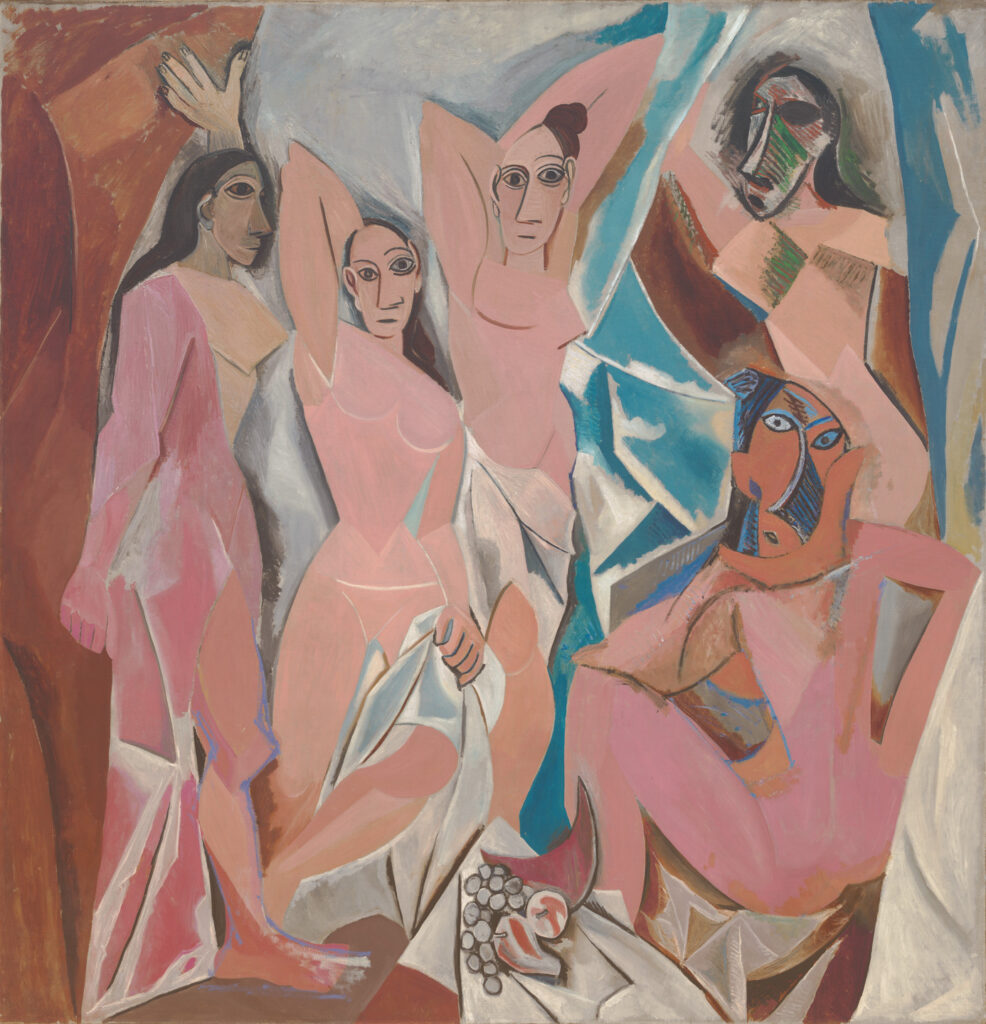
2. Portrait of Pablo Picasso
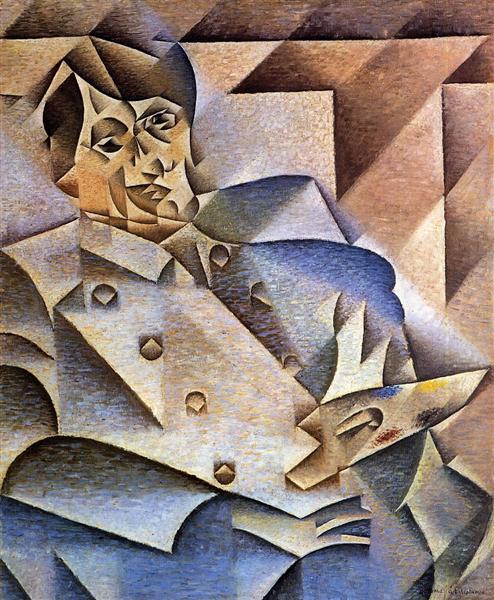
3. Girl with a Mandolin
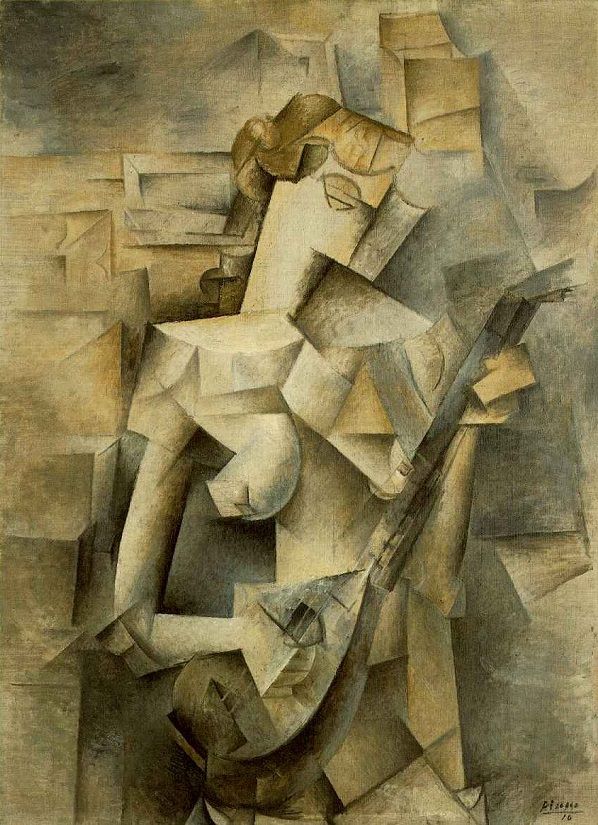
4. Houses at L’Estaque

You can read more about Cubist artwork in our Cubist Artwork Guide.
Facts about Cubism
- Jean Metzinger and Albert Gleizes’ wrote “Du Cubisme”, a treatise on Cubism, in 1912. “Du Cubisme” influenced Niels Bohr’s discovery of the principle of complementarity in quantum theory.
- Juan Gris coined the term Analytical Cubism to describe the first significant phase of Cubism.
- Georges Braque was the first living artist to have a solo exhibition at the Louvre in Paris.
- Pablo Picasso produced over 150,000 artworks in his lifetime. He lived to 91 years of age.
- Cubism is considered the first Abstract Art movement, even though the achievement of abstraction in Cubist artwork was not a focal point of the movement’s style.
- Cubism is closely related to Realism.
- Cubism was initially rejected by many galleries, art academies, and veteran artists for its unconventional style and concept.
- In 1911, the first Cubist exhibition, Salon des Indépendants, did not include Cubism’s founders, Pablo Picasso and Georges Braque.
- The term Cubism originated from a criticism from art critic Louis Vauxelles in 1908, who described Georges Braque’s paintings as a reduction of the subjects to “cube-like oddities,” among other mocking comments.
- Cubism is one of the most influential art styles of the 20th century.
- German art dealer and historian Daniel-Henry Kahnweiler paid Picasso and Braque a wage that allowed them to make art for a living. Their funding was fundamental to the success of Cubism.
- Filipino artist Vicente Manansala developed Transparent Cubism, which uses layers of transparent paint rather than opaque layers typical of French Cubism.
- Cubist artwork is among the most stolen throughout history. During World War II, much of Paul Klee’s art was seized from museums and Jewish collectors by Nazis. Pablo Picasso’s art is also the most stolen of any other artist.
- Pablo Picasso believed that Cubism was true to life because it represented the physical reality of its subjects.
- Outside Europe and the west, Cubism first reached Japan and China via European texts translated and published in Japanese art journals in the 1910s.
- Cubism influenced Western literature, especially writers such as Virginia Woolf, James Joyce, William Faulkner, and Gertrude Stein, who employed repetition and converging perspectives across their texts.
- In the 1920s, Cubist sculpture became popular through artists such as Joseph Csaky, Alexander Archipenko, Pablo Picasso, and more.
- Influenced by Cubism, photographers Aleksander Rodchenko, László Moholy-Nagy, and Paul Strand used creative darkroom techniques to create geometric repetitions and layered compositions.
Cubism vs. Surrealism
Cubism and Surrealism are filled with familiar objects that appear strange or mysterious because they challenge our perception of the world around us. Both movements underwent two significant phases that marked an evolution in style and technique, envisioned reality in a new or alternate way, and contained elements of abstraction, both intended and involuntary.
While Cubism and Surrealism share many similarities, their influences are very different. Surrealism makes use of illusionism, where Cubism rejects it entirely. Cubism was also renowned as a visual arts movement, whereas Surrealism, best known as an art movement, was part of a broader cultural movement in response to the second World War including film and literature.
Although Cubism and Surrealism did not have a clear or direct influence on each other, these famous avant-garde art movements were closely related to coexisting movements such as Dadaism and Post-Impressionism. Many Dada, Cubist, and Post-Impressionist artists, such as Frida Kahlo and Salvador Dalí, dabbled in Cubism before finding their roots in the movements that define them. Even as a famed Cubist, much of Pablo Picasso’s work throughout the 1920s incorporates characteristics of Surrealism and his style changed throughout the many decades of this artistic career.
For more information, see our full guide on Surrealism.
Cubism vs. Futurism
Futurism was a modern art movement that began in Italy in the early 20th century. Futurism celebrates the dynamism of modern life, advances in technology, youth, and violence. Italian poet Filippo Tommaso Marinetti (1876 – 1944) founded Futurism in the visual arts. In 1909, Marinetti announced the movement’s birth in his Futurist Manifesto. Italian painters Umberto Boccioni, Carlo Carrà, Giacomo Balla, and Gino Severini were also key figures in the movement. Futurism was also popular in Russia. Similar to Cubism, Futurism dissolved with the coming of World War I but was later briefly revived by Marinetti.
Cubism and Divisionism influenced Futurism and many Futurist paintings appear to have a similar stylistic qualities to those of Cubism and Divisionism. However, Futurist artists sought a more dynamic composition than that of Cubism. Futurists were inspired by technological progress and aimed to convey its thrilling energy. New scientific developments, such as agile automobiles, booming airplanes, and high-speed trains, fueled the Futurists’ desire to include racing cyclists, airplanes, and even people in motion as their subjects.
Despite seeking to differentiate themselves from Cubists, Futurist artists built upon the Cubist technique of showing multiple viewpoints of an object in the same painting using fragmented planes. Futurist painters blended transparent and opaque layers of paint to overlay a subject’s many positions while in motion. Futurist artists created the illusion of motion using repetitive brush strokes in paintings and repeated forms in sculpture. The result of these techniques was a dynamic, energetic artwork whose subjects appeared to be in constant motion.
The Futurist color palette was much brighter and more vibrant than that of Cubism. The influence of Cubism and Divisionism is seen in the broken colors and short bruskstrokes of Futurism, which often appear as fields of stippled stripes and dots.
You can read more about Futurism in our Futurism Guide.
